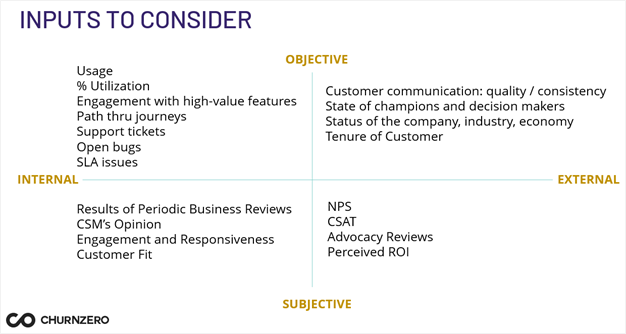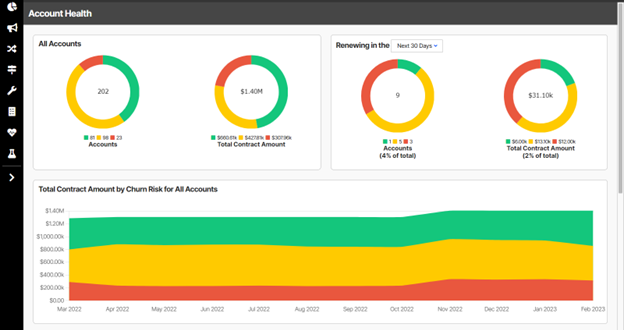Webinar – Customer Health Scores: Why They Matter and How to Build Them
In any economic downturn, companies have to work to accomplish more with less — optimizing product, customer success, and Net Revenue Retention (NRR) while reducing costs and controlling headcount.
That’s exactly what bootstrapped SaaS companies have been doing for years, argues You Mon Tsang, CEO and Cofounder of ChurnZero, a customer success platform. Bootstrapped companies understand the importance of retention and rely on Customer Success, a team that can benefit from the development of a Customer Health Score.
In this webinar, Mainsail’s Phil Stern hosts Tsang to learn the ins and outs of Customer Health Scores and how to use them effectively to impact your company’s growth.
The Rise of Net Revenue Retention
Tsang kicks off the webinar with a history lesson in the SaaS metrics that he believes matter, purporting that Net Revenue Retention (NRR) is the most important metric for SaaS companies today. This wasn’t always the case, says Tsang, but a shift toward subscription models increased the importance of retention, especially when working to secure funding.
Research from a SaaS Capital study of the 50 transactions from private B2B SaaS companies in 2021-2022 indicates that three variables are key during valuation:
- The Public Market Index
- Overall ARR growth rate
- Net Revenue Retention
Because companies can’t control the Public Market Index, Customer Success and NRR become the focus. Tsang recommends investing in Customer Success and Customer Intelligence for any SaaS business whether that means purchasing a Customer Success platform or simply applying appropriate resources to the function.
What is a Customer Health Score? (From a B2B point of view)
A Customer Health Score is a metric used to measure the overall well-being of a relationship with a customer. This score provides a simple, quantitative assessment that allows Customer Success teams to prioritize and allocate resources properly.
A Customer Health Score dashboard can take many shapes. Some companies use a 0-100 scale while others use “red, yellow, and green” indicators, and some use both. The scale or colors on the dashboard are less important than the metrics you use to build the score.
How to create a Customer Health Score
There are several data inputs to consider when building a Customer Health Score. To ensure your data is accurate and nuanced, Tsang recommends tracking a blend of internally and externally informed factors, using both factual and subjective data. The inputs should be unique to your business, informed by what generates success for your customers.
Tsang categorized his recommended inputs into four quadrants:


If you’re unsure which inputs to include, start with the inputs you know you can access. For many companies, that will be:
- Net Promotoer Score (NPS) and Customer Satisfaction Score (CSAT)
- Product usage
- Customer Success Manager sentiment
Once you have these down, you can scale and adjust your inputs as the business grows.
Beware: it’s easy to overdo the data. A quality Customer Health Score has five to ten inputs that both matter to your organization and will drive accurate scores. If you have more than 10 inputs, consider scaling back so you can easily identify the variables and learn how to react.
Create custom Customer Health Scores per segment
A company should have multiple health scores to analyze segments of customers at different points in the life cycle, as inputs and levers will likely change over time. (Consider how it would be difficult to score an onboarding customer using the same factors as one who’s been with you for five years.)
As an example, ChurnZero segments customers into three health score buckets: onboarding, one-year and two+ years. The onboarding health score focuses on task-based and time-based metrics, while the two+ year health score is all about referrals, references and continued adoption.
If you’re just getting started with building a health score, Tsang recommends starting with the “bucket” where you have most of your customers.
Two Examples of Customer Health Scores
(Using ChurnZero as an example)


Once you feel comfortable with your segmentation, further segment by — for example — product edition and/or available features, services purchased, company and user base size, industry, and current and potential revenue.
Leveraging your Customer Health Scores
With a dashboard set up, your Customer Health Scores can quickly provide insight into how your accounts are doing. At ChurnZero, Tsang measures health with “red, yellow, green” indicators, so his dashboard looks like this:


Focus on change over time. “It doesn’t matter what color your pie graphs are; what’s more important is the change over time,” says Tsang. Track long-term and short-term metrics and check back every month.
Use the dashboard to prioritize. Using a three-color scheme as in the above, CSMs would know to work on (1) high-value yellow/medium-risk companies, (2) high-value red companies then (3) low-value yellow and red companies (in that order)—all while maintaining positive relationships with green customers.
Evolve the product based on your findings. Customer Health Scores help reveal product needs for various segments, which can guide your business strategy. Use these insights to tweak and improve your product functionality based on a particular segment’s needs.
Dig deeper. Segment more to explore what the data is telling you. Adjust your dashboard to segment by industry, size of business, customer relationships, and which of your sales team members are bringing in the right (and wrong) types of customers.
Automate alerts. Use your dashboard to implement automated alerts, communications, tasks and processes. For example, if an account’s health score decreases, have the system alert the CSM to book time for additional coaching on how to work with a specific customer to increase their health score.
Share the news. Push the information you glean out to your entire company. This knowledge will help the management team understand the health of a customer and the account managers know who to target and how.
The business benefits of having a Customer Health Score
As CS teams evolve to become more critical to SaaS businesses, accurate retention and growth forecasting has become a leading priority. Having a Customer Health Score locked down can generate more accurate forecasting, which CS teams can use to help a company avoid pending churn, improve expense management and staff appropriately. Forecasting also moves the needle when reporting to the Board and the C-suite.
“The business benefits are clear, and so are the relationship benefits. If you’re coming in with strong forecast, you’ll earn a seat at the table” says Tsang.
Best practices for Customer Health Scores
Tsang wraps up with a handful of tactical best practices for implementing Customer Health Scores in your company. They included:
- Just start! Choose 3-5 data points to track and update them monthly using Excel.
- Find ways to automate using real-time data. Add data and update continuously.
- Invest in the process: Develop multiple health scores, iterate and re-iterate, test and re-test.
- Who stayed? Review scores of renewed accounts.
- Who left? Review accounts with healthy scores that didn’t renew.
- Segment further to gain deeper insights.
- Weigh factors differently for more accurate insights.
Make it the new normal
Again, the goal of a Customer Health Score is to provide a simple, quantitative assessment that will allow your Customer Success team to prioritize and allocate resources effectively. Once you have developed your Customer Health Score and honed in on how to make it optimally impactful for your company, it will become foundational.
The result, ideally, will be increased efficiency and retention.
And in 2023, when efficiency is key, it can be crucial for companies to invest in this kind of tool. Mainsail would feel that efficiency is always key, regardless of the year. It’s other parts of the SaaS industry that are just waking up to this.
The information herein is based on the speaker’s opinions and views and there can be no assurance other third-party analyses would reach the same conclusions as those provided herein. The information herein is not and may not be relied on in any manner as, legal, tax, business or investment advice.
Third-party images, logos, and references included herein are provided for illustrative purposes only. Inclusion of such images, logos, and references does not imply affiliation with or endorsement for or by such firms or businesses.
Certain information contained in this content piece has been obtained from published and non‐published sources prepared by other parties, which in certain cases have not been updated through the date hereof. While such information is believed to be reliable for the purposes of this content piece, neither Mainsail nor the author assume any responsibility for the accuracy or completeness of such information and such information has not been independently verified by either of them. The content piece will not be updated or otherwise revised to reflect information that subsequently becomes available, or circumstances existing or changes occurring after the date hereof, or for any other reason.
Certain information contained herein constitutes “forward-looking statements,” which can be identified by the use of terms such as “may,” “will,” “should,” “could,” “would,” “predicts,” “potential,” “continue,” “expects,” “anticipates,” “projects,” “future,” “targets,” “intends,” “plans,” “believes,” “estimates” (or the negatives thereof) or other variations thereon or comparable terminology. Forward looking statements are subject to a number of risks and uncertainties, which are beyond the control of Mainsail. Actual results, performance, prospects or opportunities could differ materially from those expressed in or implied by the forward-looking statements. Additional risks of which Mainsail is not currently aware also could cause actual results to differ. In light of these risks, uncertainties and assumptions, you should not place undue reliance on any forward-looking statements. The forward-looking events discussed in this content piece may not occur. Mainsail undertakes no obligation to update or revise any forward-looking statements, whether as a result of new information, future events or otherwise.
No representation, warranty or undertaking, express or implied, is given as to the accuracy or completeness of the information or opinions contained in the enclosed materials by Mainsail and no liability is accepted by such persons for the accuracy or completeness of any such information or opinions. For additional important disclosures, please click here.

